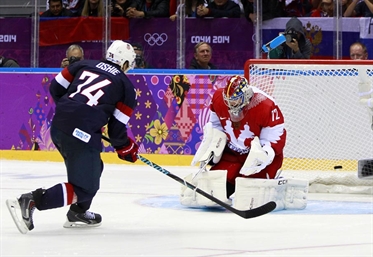 |
| Game winner by T.J. Oshie. |
They played a mostly-cautious overtime (only five minutes—it will be ten minutes in the playoff rounds), and then went to a shootout. (“game winning shots” in IIHF parlance). Cue my refrain: “I hate shootouts.” I hate them in soccer as well as hockey, even though the team I coached won one on the way to our championship. It’s a team game, so it should be decided by the same skills and teamwork the rest of the game entails. And when two teams have played evenly for 60 minutes or more, they deserve recognition.
I reminded the skating parents and other onlookers that IIHF rules for shootouts are different from NHL rules: particularly in letting shooters go again if the game is not decided on the first three attempts. T.J. Oshie kept shooting for USA, which I think was a great coaching call, since Sergei Bobrovsky’s greatest weakness is not his glove hand or his ability to butterfly, but between his ears. Sending the same shooter who beat him earlier may have helped shake his confidence, and sending Oshie back even after missing a couple of attempts send “Bob” a message that Coach Bylsma thought Oshie would get the job done.
When it went to a shootout, and then to sudden-death, I was figuring Russia to win, with talent like Alex Ovechkin, Ilya Kovalchuk, and Pavel Datsyuk. But Jonathan Quick was just good enough to give Oshie another opportunity to win the game. Great outcome, but I would have been just as happy with a well-earned tie.
This weekend’s puzzles definitely will have you working overtime: especially the Wall Street Journal, where they’ve brought us something new by Patrick Berry. It’s called “Way Stations.” Don’t feel bad if you have to print out another copy after messing up the first. If you’ve done the Pathfinders by Nathan Curtis, you’ll have a leg up here.
Speaking of Nathan, he’s back with a new Snake Charmer, and with news of his recent activities, which include creating a puzzle hunt for the National Museum of Math and constructing for a new print magazine of variety puzzles edited by the ubiquitous Will Shortz. 19 bucks for six issues with 50 puzzles each. With Nathan, Patrick, BEQ and Trip Payne in the lineup, the quality of the puzzles ought to be great.
More news on big puzzle projects: the Cryptic All-Stars have put their book to bed and sent out PDFs of the print edition, along with a note that they’re still working on the e-book edition. At the rate new puzzles are coming out, I’m gonna need a bigger clipboard. Congratulations, everyone; I’ll post a review next week.
The New York Times puzzle this weekend (behind the paywall) is a diagramless by Fred Piscop. Deb says it’s easy, and she’s not a big fan of variety crosswords, so this might be a good one for those of you who’ve never tried a diagramless before. Blizzard permitting, I’ll post the solution here tomorrow: note it will be bumped under this post, so scroll down to find it.
Meanwhile, cryptic solvers can go one-on-one with Hex (National Post) and with Fraser Simpson (Globe and Mail: Java/print). Falcon reports that Hex constructed a Valentine’s theme; we’ll hope Emily and Henry were cluing sweet nothings to each other as they worked on the puzzle.
No comments:
Post a Comment
If you're responding to a hint request, please remember not to give more information than necessary. More direct hints are allowed after Monday.